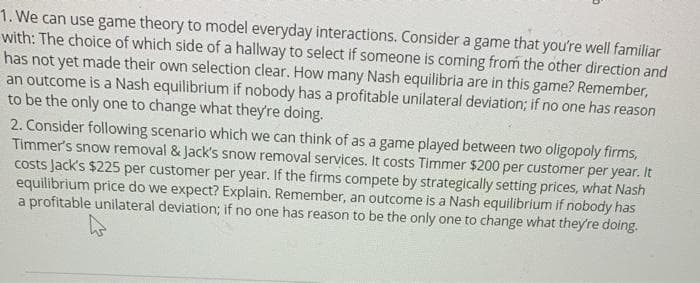1. We can use game theory to model everyday interactions. Consider a game that you're well familiar with: The choice of which side of a hallway to select if someone is coming from the other direction and has not yet made their own selection clear. How many Nash equilibria are in this game? Remember, an outcome is a Nash equilibrium if nobody has a profitable unilateral deviation; if no one has reason to be the only one to change what they're doing. 2. Consider following scenario which we can think of as a game played between two oligopoly firms, Timmer's snow removal & Jack's snow removal services. It costs Timmer $200 per customer per year. It costs Jack's $225 per customer per year. If the firms compete by strategically setting prices, what Nash equilibrium price do we expect? Explain. Remember, an outcome is a Nash equilibrium if nobody has a profitable unilateral deviation; if no one has reason to be the only one to change what they're doing.
1. We can use game theory to model everyday interactions. Consider a game that you're well familiar with: The choice of which side of a hallway to select if someone is coming from the other direction and has not yet made their own selection clear. How many Nash equilibria are in this game? Remember, an outcome is a Nash equilibrium if nobody has a profitable unilateral deviation; if no one has reason to be the only one to change what they're doing. 2. Consider following scenario which we can think of as a game played between two oligopoly firms, Timmer's snow removal & Jack's snow removal services. It costs Timmer $200 per customer per year. It costs Jack's $225 per customer per year. If the firms compete by strategically setting prices, what Nash equilibrium price do we expect? Explain. Remember, an outcome is a Nash equilibrium if nobody has a profitable unilateral deviation; if no one has reason to be the only one to change what they're doing.
Chapter8: Game Theory
Section: Chapter Questions
Problem 8.9P
Related questions
Question

Transcribed Image Text:1. We can use game theory to model everyday interactions. Consider a game that you're well familiar
with: The choice of which side of a hallway to select if someone is coming from the other direction and
has not yet made their own selection clear. How many Nash equilibria are in this game? Remember,
an outcome is a Nash equilibrium if nobody has a profitable unilateral deviation; if no one has reason
to be the only one to change what they're doing.
2. Consider following scenario which we can think of as a game played between two oligopoly firms,
Timmer's snow removal & Jack's snow removal services. It costs Timmer $200 per customer per year. It
costs Jack's $225 per customer per year. If the firms compete by strategically setting prices, what Nash
equilibrium price do we expect? Explain. Remember, an outcome is a Nash equilibrium if nobody has
a profitable unilateral deviation; if no one has reason to be the only one to change what they're doing.
Expert Solution
This question has been solved!
Explore an expertly crafted, step-by-step solution for a thorough understanding of key concepts.
This is a popular solution!
Trending now
This is a popular solution!
Step by step
Solved in 2 steps

Knowledge Booster
Learn more about
Need a deep-dive on the concept behind this application? Look no further. Learn more about this topic, economics and related others by exploring similar questions and additional content below.Recommended textbooks for you


Principles of Economics (MindTap Course List)
Economics
ISBN:
9781305585126
Author:
N. Gregory Mankiw
Publisher:
Cengage Learning

Principles of Economics, 7th Edition (MindTap Cou…
Economics
ISBN:
9781285165875
Author:
N. Gregory Mankiw
Publisher:
Cengage Learning


Principles of Economics (MindTap Course List)
Economics
ISBN:
9781305585126
Author:
N. Gregory Mankiw
Publisher:
Cengage Learning

Principles of Economics, 7th Edition (MindTap Cou…
Economics
ISBN:
9781285165875
Author:
N. Gregory Mankiw
Publisher:
Cengage Learning

Principles of Microeconomics (MindTap Course List)
Economics
ISBN:
9781305971493
Author:
N. Gregory Mankiw
Publisher:
Cengage Learning

Principles of Microeconomics
Economics
ISBN:
9781305156050
Author:
N. Gregory Mankiw
Publisher:
Cengage Learning

Microeconomics: Principles & Policy
Economics
ISBN:
9781337794992
Author:
William J. Baumol, Alan S. Blinder, John L. Solow
Publisher:
Cengage Learning